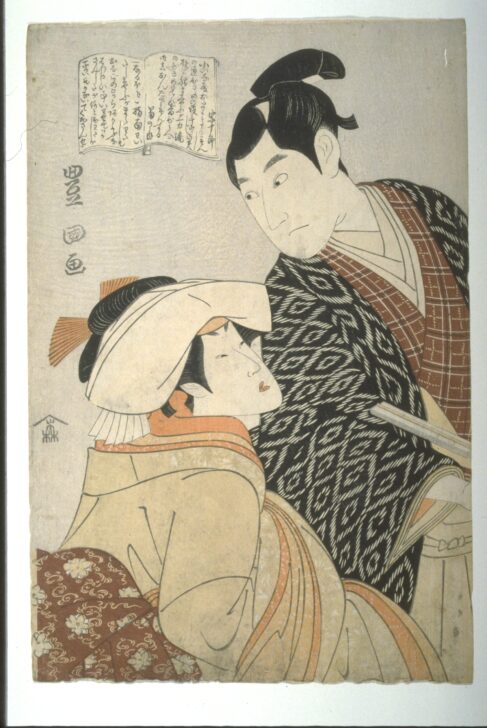Fall Play: Moon Over the Musashino Plain: Sawamura Sōjūrō III as Inanoya Hanjūrō and Segawa Kikunojō III as Koina
Utagawa Toyokuni I

Description
In the mid-1790s, Toyokuni turned from the statuesque beauties of Kiyonaga to a new subject—actor prints—and a new model, the "big head" (ôkubi e) close-ups done by artists of the Katsukawa School from the late 1780s onward. Here we have Toyokuni’s rendering of the protagonists of a play performed for New Year’s in 1794: the dashing Sawamuro Sôjûrô III at right, in the role of Hanbei, and the famous female impersonator Segawa Kikunojô III at lower left as Koina, his wife. (Married women of upper-class status often wore white cloths wrapped around their head, to protect their oiled coiffures.)
In prints of this era, Sôjurô is immediately recognizable by his watermelon-seed eyes and oval face; likewise, Kikunojô is always drawn with a razor-sharp chin, suggesting that these are physiognomic traits of the actors rather than related to specific roles. From the mid-seventeenth century to the present day, female roles in kabuki were enacted by men, often actors who specialized exclusively as onnagata, or female impersonators. Just as their choices in costume dictated fashion trends, their stylized gestures and high-pitched voices—necessary to create the illusion of femininity on the stage—affected the behavior of "real" women.
M. Graybill
"Courtesans, Cross-Dressers, and the Girl Next Door Images of the Feminine in Japanese Popular Prints"
3/9 - 9/1/02
Subject Matter:
Actor Sawamura Sōjūrō III was born in 1753 and was active in kabuki from 1760 until his death in 1801. He was famous for both historical plays (jidaimono) and plays concerned with the everyday lives of commoners (sewamono).
Actor Segawa Kikunojō III was also known as Segawa Senjo. He was born in Osaka in 1751 to a family of kabuki actors. He was active in kabuki from 1765 until his death in 1810. He was known for his roles in sewamono and as an onnagata (“female form” or “female role”).
Physical Description:
A man and woman gaze at each other in this print. The woman wears a yellow robe with a red sash and white head cover. The man wears a blue and white coat with geometric patterns over a red robe. At the top is a cartouche with calligraphy.
Inscriptions: Artist's signature: Toyokuni ga; Publisher's seal: Mori
Usage Rights:
If you are interested in using an image for a publication, please visit https://umma.umich.edu/request-image/ for more information and to fill out the online Image Rights and Reproductions Request Form.